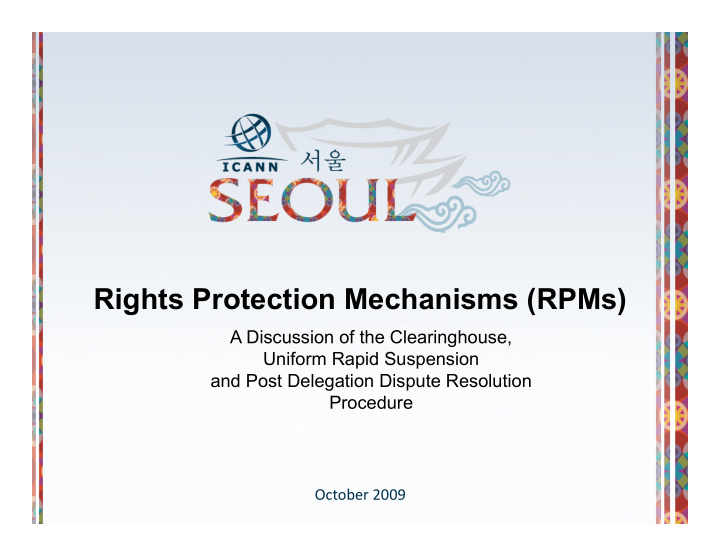



Rights Protection Mechanisms (RPMs) A Discussion of the Clearinghouse, Uniform Rapid Suspension and Post Delegation Dispute Resolution Procedure October 2009
Development of Rights Protec4on Mechanisms • Implementa2on Recommenda2on Team (IRT) forma2on, work & report recommending specific Rights Protec2on Mechanisms (RPMs) • Public consulta2ons – Online forum (200+ comments) – Sydney, New York, London mee2ngs • Analysis of public comment • Recommenda2ons for specific new gTLD RPMs • Referral of certain recommenda2ons to GNSO Workshop: Dr. Bruce Tonkin, Moderator 2
RPMs – Registry Lifecycle REGISTRY LIFECYCLE PRE-LAUNCH LAUNCH ONGOING OPERATIONS IP CLEARINGHOUSE URS IP CLAIMS POST-DELEGATION PROCIESS SUNRISE PROPOSED UDRP RPMs October 2009
Trademark (IP) Clearinghouse – What is it? • A single database of authen2cated registered trademarks and authen2cated unregistered marks • Two func2ons: – validate trademarks – provide data for pre‐launch claims or sunrise services • Replaces need for: – Trademark holders to register in many databases as TLDs are launched – Registries to develop IP Claims and Sunrise processes (registries choose which legal rights are recognized in their processes) • Operated by third‐party license or agreement with ICANN 4
Trademark Clearinghouse – What’s changed? • Call it “Trademark” (not “IP”) Clearinghouse to reflect tailored purpose • Limited terms of use instead of license for data • Does not include GPML • Divided responsibility for trademark valida2on and database administra2on to avoid poten2al abuses October 2009
Trademark Clearinghouse Discussion 1. Should the IRT recommenda2on for GPML be included in the set of adopted rights protec2on mechanisms? 2. What should the rela2onship be between ICANN & clearinghouse? 3. One clearinghouse or regional clearinghouses? 4. Does the IP Claims service have a chilling effect on poten2al registra2ons? 5. How can data on unregistered rights on names be consistently validated? October 2009
Uniform Rapid Suspension (URS) ‐ What is it? • Rapid relief to trademark holders for the most clear‐cut cases of infringement • Higher burden of proof than UDRP • Filing fee set by URS provider • Expected fee in range of $300 • Results only in suspension, not transfer of name 7
URS – What’s Changed? • Proposed as best prac2ce, but incented by evalua2on process • No fee to defend any number of names • 14 days to answer, plus 7‐day extension upon request • No2ce by fax, in addi2on to email and postal mail 8
URS Discussion 1. If adopted, should the URS be mandatory or a best prac2ce? 2. Balance the short response 2me (14 days) against the need to keep the “R’” in URS. 3. Can the fee level (similar to the Nominet £300 fee) be aiained? 4. What if there is an incorrect decision? 5. What is the “reinstatement” process? October 2009
Post‐Delega4on DRP (PDDRP) – What is it? • Addresses systemic cyber‐squajng in new gTLD registries • A claim of rights infringement against registry filed with a dispute resolu2on provider • Independent dispute resolu2on process • Remedies include sanc2ons, suspension, and termina2on … • Separately, a registry agreement contract breach: − should be reported to ICANN − will be addressed by ICANN Contractual Compliance October 2009
Compliance reports ICANN DRP Compliance Enforcement Report REGISTRY RIGHTS HOLDER
Infringement of rights claims ICANN DRP Report (3) Infringement of Answer (2) Rights Claim (1) REGISTRY RIGHTS HOLDER
PDDRP – What’s Changed? • Requires clear and convincing evidence of affirma2ve conduct by registry operator • Mere knowledge by registry operator of infringement by third par2es not ac2onable • ICANN not a party to disputes between trademark holders and registries – eliminates 45‐day ICANN inves2ga2on before filing with DRP • Both sides pre‐pay; refund to prevailing party • Registry operator loses if it fails to respond October 2009
Post‐delega4on Discussion 1. Should ICANN perform first evalua2on of claims of rights infringement (prior to independent dispute resolu2on considera2on)? 2. What mechanisms can discourage frivolous or abusive rights infringements claims? October 2009
Discussion 15
Trademark Clearinghouse Discussion 1. Should the IRT recommenda2on for GPML be included in the set of adopted rights protec2on mechanisms? 2. What should the rela2onship be between ICANN & clearinghouse? 3. One clearinghouse or regional clearinghouses? 4. Does the IP Claims service have a chilling effect on poten2al registra2ons? 5. How can data on unregistered marks be consistently validated? October 2009
URS Discussion 1. If adopted, should the URS be mandatory or a best prac2ce? 2. Balance the short response 2me (14 days) against the need to keep the “R’” in URS. 3. Can the fee level (similar to the Nominet £300 fee) be aiained? 4. What if there is an incorrect decision? October 2009
Post‐delega4on Discussion 1. Should ICANN perform first evalua2on of claims of rights infringement (prior to independent dispute resolu2on considera2on)? 2. What mechanisms can discourage frivolous or abusive rights infringements claims? October 2009
Thank You 19
Recommend
More recommend